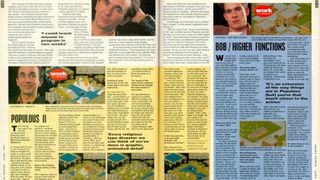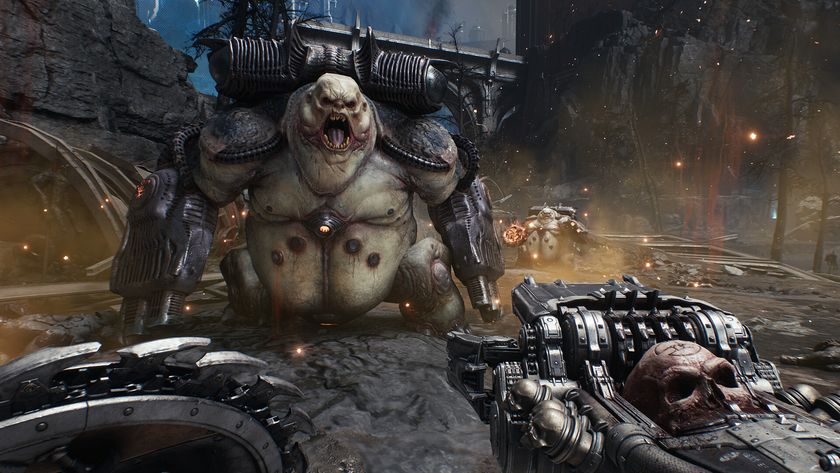What was Peter Molyneux's magic formula for addictive Amiga games?
Amiga Power talked Bullfrog's beginnings with the God of God sims in 1991
During their visit to Bullfrog, Amiga Power took a look at the games under development back in 1991. Here's what they discovered about the Populous sequel, along with 'Bob' (which eventually became another massive name Bullfrog game – if, after reading the piece below you still can't guess what, we shall reveal all), and Creation…
Populous II
This is the big one, I guess, the one that everybody's been wondering about.
So, Peter, how's it different to the first Populous?
To a large extent it's just a case of fixing all the things we thought were wrong, or at least could have been improved, in the first one. The gameplay is basically the same – except for one major difference which I'm not going into at the moment – but there are lots of effects in here that you didn't get in Populous.
There are about 40 new ones in fact – some of which are brand new, some of which we had in early versions of the first game but dropped somewhere along the line. These include columns of fire, plagues and pestilence, whirlpools, tidal waves, water spouts and so on. Every religious type disaster we can think of we've done in graphic, animated detail. There's even the parting of the Red Sea in there! Not all the effects will be destructive however – you'll be able to fertilise your land so that it produces food faster, which you couldn't do in the first game.
What's the thinking behind adding all this stuff?
We're hoping to make it a bit more hectic than the first Populous, more visual and much more of an action game. The effects will play a more important part in the sequence of events – to help with that we've got the basic display working eight times faster than the first game, for instance.
Get daily insight, inspiration and deals in your inbox
Sign up for breaking news, reviews, opinion, top tech deals, and more.
You'll see whirlwinds picking people up and throwing them about – each time an effect is used it will have a consequence, and in this case it'd be that the people spread out faster, because they've been thrown around by the whirlwind.
We'll have it possible to change the land to channel these natural disasters too – columns of fire will always try to seek high land for instance, so if you build the ground up you can actually turn it round and direct it back at your enemy!
One thing we've aimed for is having an unpredictability about everything – when you cast an effect, you'll never be sure quite what it will do. It could damage your own town, for instance. We're hoping to have hundreds of frames of specialist animation in here, to make it all as visual as possible.
Looking at what you've got so far, the towns look a lot more impressive.
Yes, we've set it in a single time period this time – ancient Greece, so you presumably play one of the Greek gods – and have spent a lot more time on the different buildings and so on. We'll have towns joining up to make major combinations and all sorts – the more mature your city, the stronger you get.
On a normal Populous it would take half an hour to do what it'd take you five minutes with this one. The possibilities seem endless – we could do Celtic or Norse data disks for it, for instance.
The layout of the game hasn't changed all that much, though the book seems to have gone.
The view point was so original we've found it difficult to change it too much, to be honest. You can't have any display areas on the top right of the screen, because when you build the land up high it'd totally cover them up. Gary Carr, the graphic artist on this new one, eventually copied the view we've gone for from the box artwork of the original Populous, rather than from the game itself.

Bob (Higher Functions)
When I first heard of this I thought 'Bob' must be the name of some cute little platform game character, perhaps like the chappie in Flood – but no, it is, in fact, merely a working title, something that can be typed nice and easily on your standard keyboard. In fact, there's not much that's cute about this game at all.
Actually, it's the same story with 'little.' There's not much that's little about it either. 'Bob' could quite easily be the best thing Bullfrog have ever done – all the more remarkable when you think it's being written by 20-year-old Sean Cooper, the chap who did the bulk of Flood and was a mere trainee a short while ago.
Okay then Sean, tell me about 'Bob'.
I actually prefer the other title we have for it at the moment – Higher Functions. It says more about the game.
The idea is that we're someway into the future. You play the head of a large corporation, and it's your task to use fair means or foul to become the top company in the world. It's an extension of the way things are in Populous, I guess – you don't ever get directly involved in the action yourself, but control lots of little people from afar.
What we've done on this one is we've come closer in on everything – it's still a 3D isometric design, but instead of the viewpoint being as if you were standing on a hill quite a way from the action, here you're standing maybe on the top of a large building. You're that much closer to the action.
The whole game scrolls, doesn't it?
That's right – in all directions. We've got a massive map of a city in here, and we've got it acting as much as possible like a real one. There are little cars driving around the roads, people walking about and so on, as well as an airport, monorail trains and so on. It's a living, breathing city, and one that operates to a realistic time scale. You'll get lots more traffic around at 9:00 in the morning and 5:00 at night, for instance.
The background world seems very impressive, but how does the game actually work?
When I said we've come in tighter on things, that applies to the characters you control too. Instead of manipulating whole societies, here you control just four characters. They're cyborgs created by your corporation, and they're your agents in the game. Don't treat them as robots though – they have their own personalities, and if you're not careful will run off and do their own thing rather than follow your orders.
To control them you stimulate their brains to produce more chemicals – sensory fluid to make them more aware, adrenaline to make them stronger and initiative to allow them to make their own decisions.
There's a danger to all this though – give them too much initiative and their loyalty will go. They'll just run away. Even with a low initiative level they react to their environment – if you tell one to stand in the middle of the road, he'll run off when a car looks likely to knock him down. They're not stupid.
And the missions you have to accomplish?
They're sort of secret agent/dirty business sort of things. One job may be to kill a journalist – ha ha, that's Peter's favourite! – who's going to write something bad about your corporation and so send your stock values plummeting.
A lot of the game is to do with earning money for your corporation – these cyborgs cost a lot, and the more money you make, the more you can spend on improving them, repairing them or making them more specific to one task. You can build one man up to be more technically minded, for instance. We hope to have an option where four people with linked machines could control a man each, which would be fun.
What you've got to remember is that everything's as real-world as possible – you can't be caught doing anything bad because that would damage your company.
So what stage is it at at the moment?
We've got all the basics there, but we've not decided on how all the missions or maps will work yet. We're thinking in terms of taking some bits outside of the city – perhaps into a jungle, or out onto oil rigs, ships and the like. Then there's fitting it all into half a meg, of course, but that's another problem.
[TechRadar Note: 'Bob' or Higher Functions eventually became a little known game called Syndicate which was released in 1993, if you didn't already guess.]
Creation
Creation (being worked on by programmer Glenn Corpes) is a lot further off than the other projects – one for well into next year. The basic idea is that you're messing about with creating different life forms to survive in different circumstances. It's almost an anti-God sim – it's evolution that holds sway here.
How does that work then? Well, say you have a giraffe over here on the left hand side of the screen, eating leaves and so on, while over on the right there's a large but attractive elephant.
The giraffe might reckon that having a nose that long would prove very useful for those tricky to reach higher branches, while the elephant's rather jealous of the giraffe's long neck for similar reasons. So they mate (don't worry! You won't be able to see them humping on screen!) and you get a girelephant or whatever, with a long neck and a long nose.
The idea is that you can break animals down into their constituent parts and the game is that you've got to try and create the ultimate life form – like man, say, or perhaps like ants – which can survive more or less anything.
You have to admit, this is a bit of a tricky one to get your mind around. Can you give us an example of how the game will actually work?
Okay, well say you have some giant flesh-eating 'Trisaurus Rex' creatures in this bit of land over on the top right of the map, and lots of fluffy bunny rabbits down in the bottom left. All is fine and dandy, until the game throws some changes in weather at you which send the Trisaurus Rex population down into the southwest. They're going to start eating all the bunnies, aren't they, and soon there'll be none left. What you've got to do in this instance is create a creature to drive off or eat the Trisaurus Rex population, while leaving the bunnies alone.
Here's another example: you've got a life form on an island, say a race of elks – and they're running out of food. You've got to save them, but there's nothing on the island to cross them with to create a race of swimming or flying elks, so you've got to create a life form on the mainland which will somehow contribute to save them. How about a race of beaver-type creatures who'll build a bridge, for instance?
It's all sort of like a game of consequences. As the game goes on it gets more and more complicated. Once you've created a life form there's no easy way of getting rid of it – you've got to cope with the actions of whatever it is you've come up with.
[TechRadar Note: Creation was a long time in development, and was eventually cancelled in 1997, sadly.]












